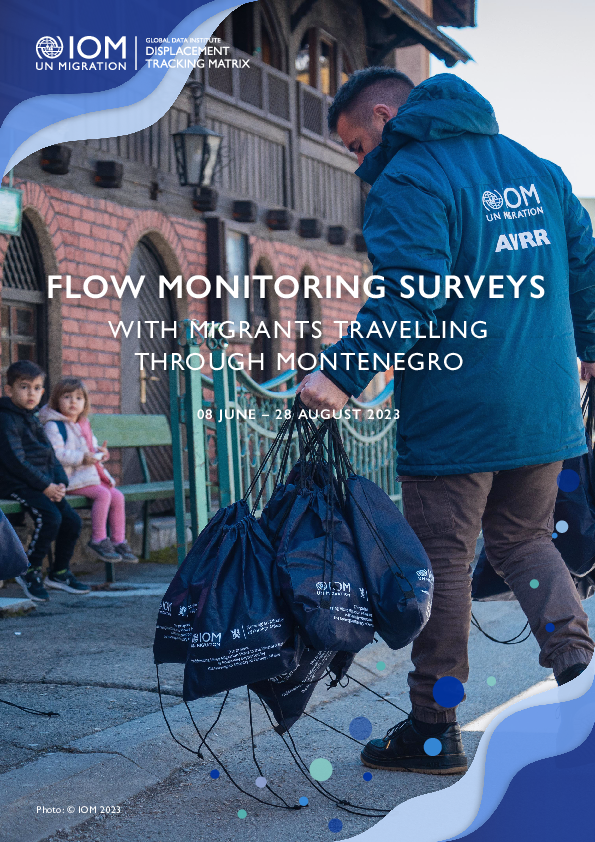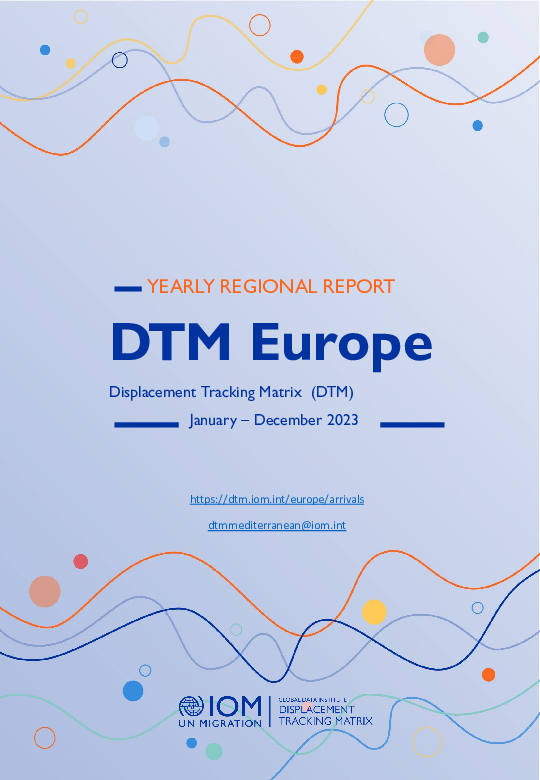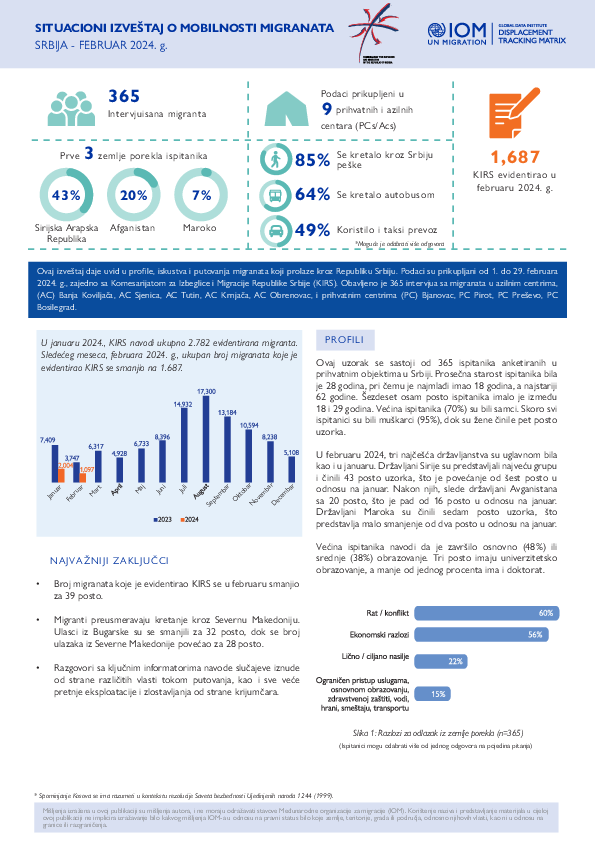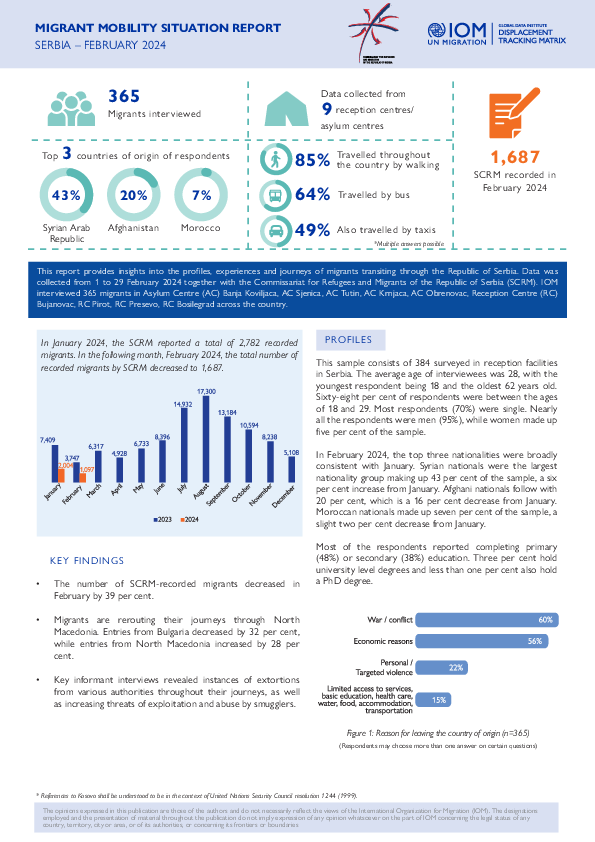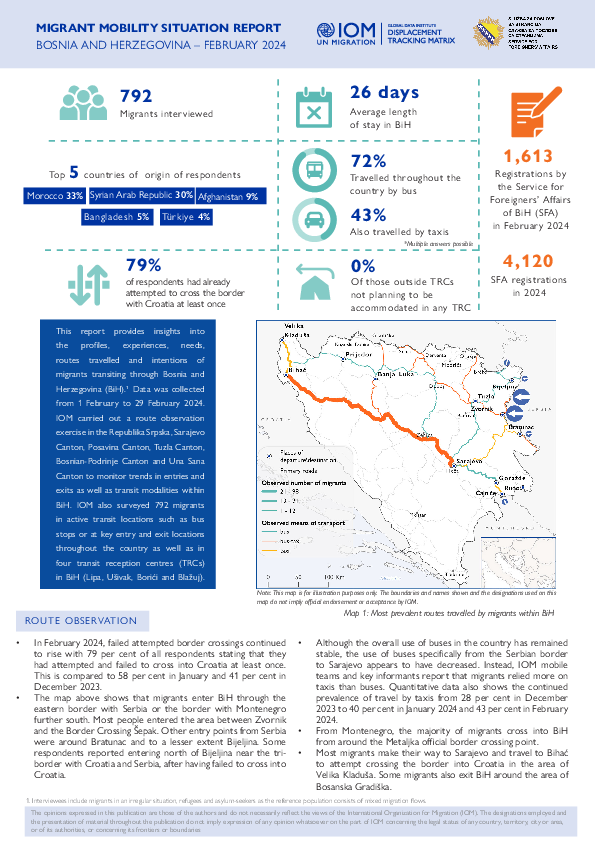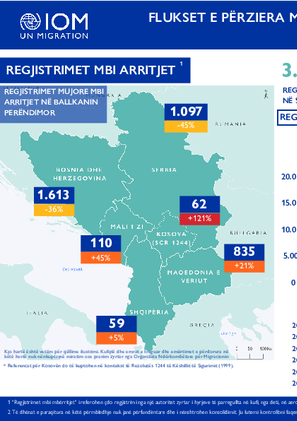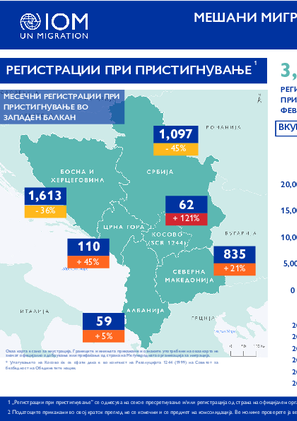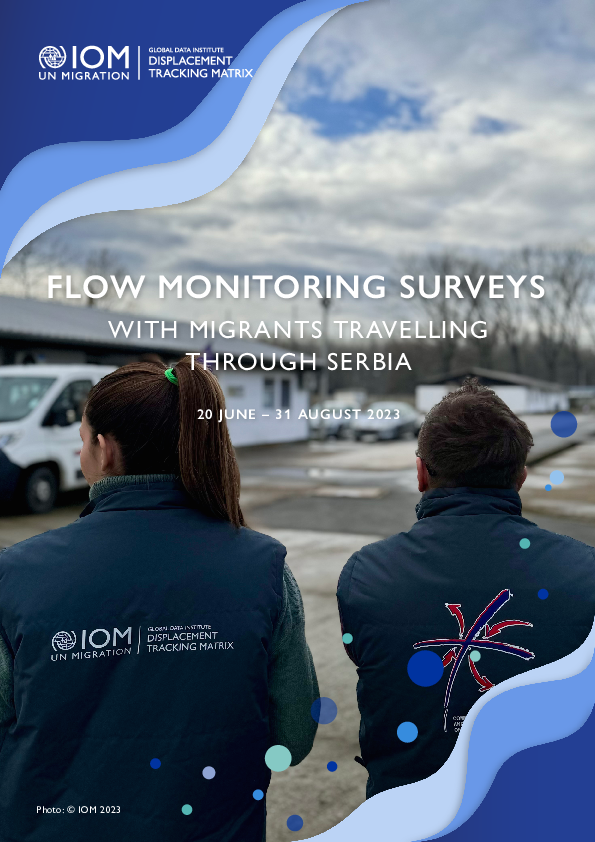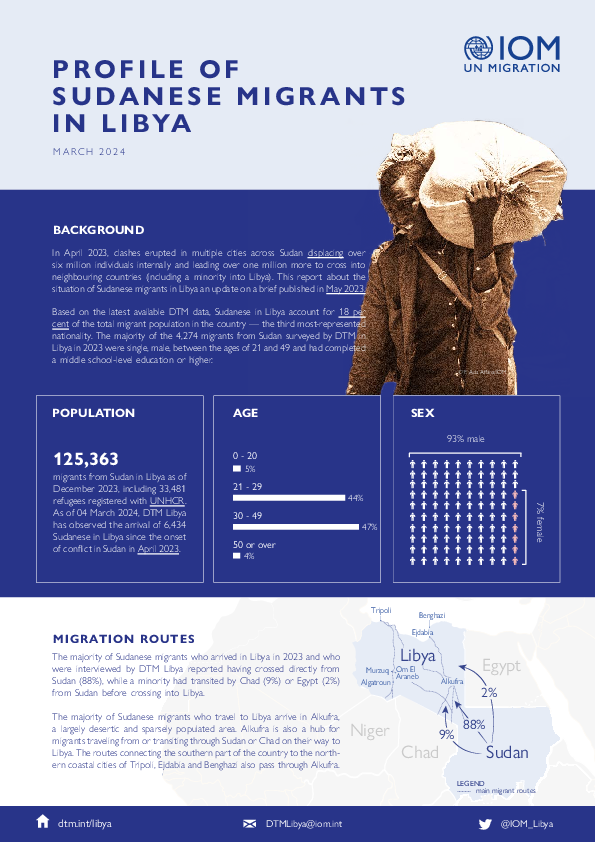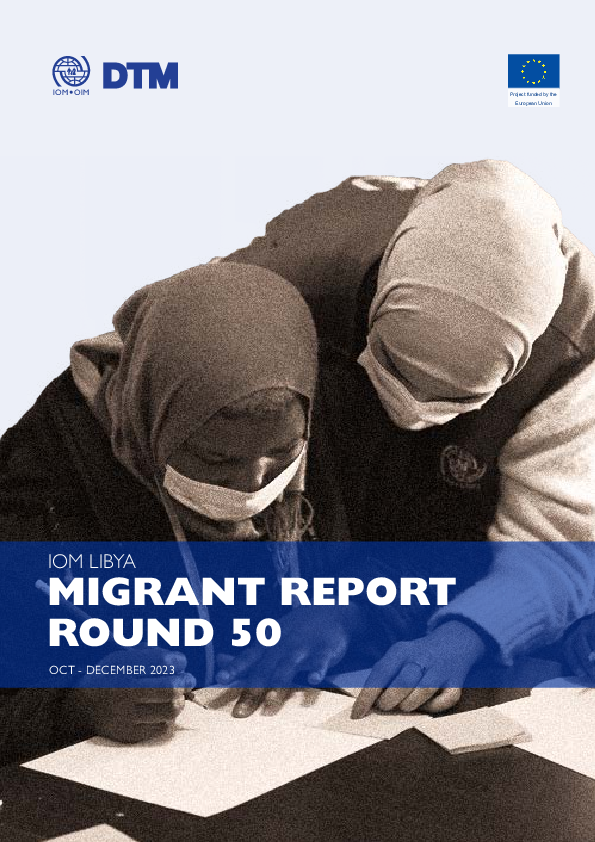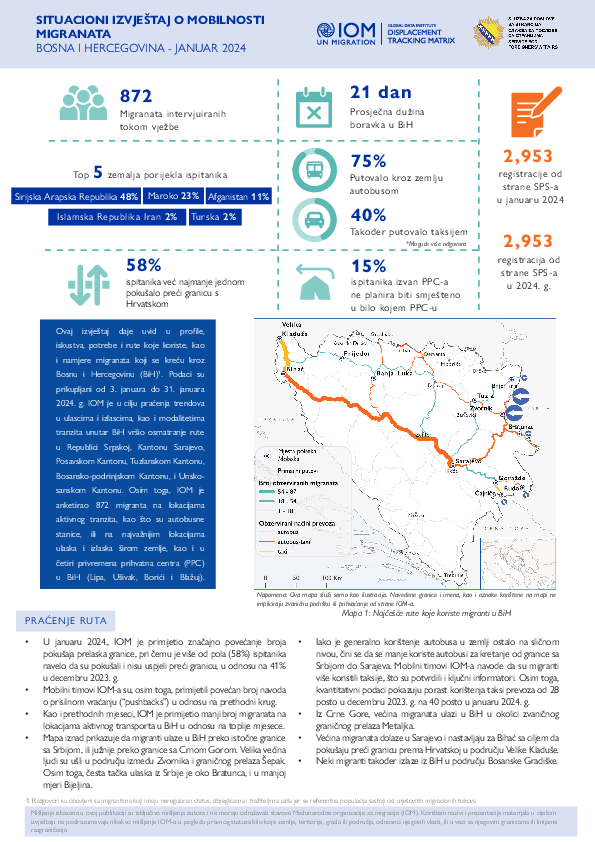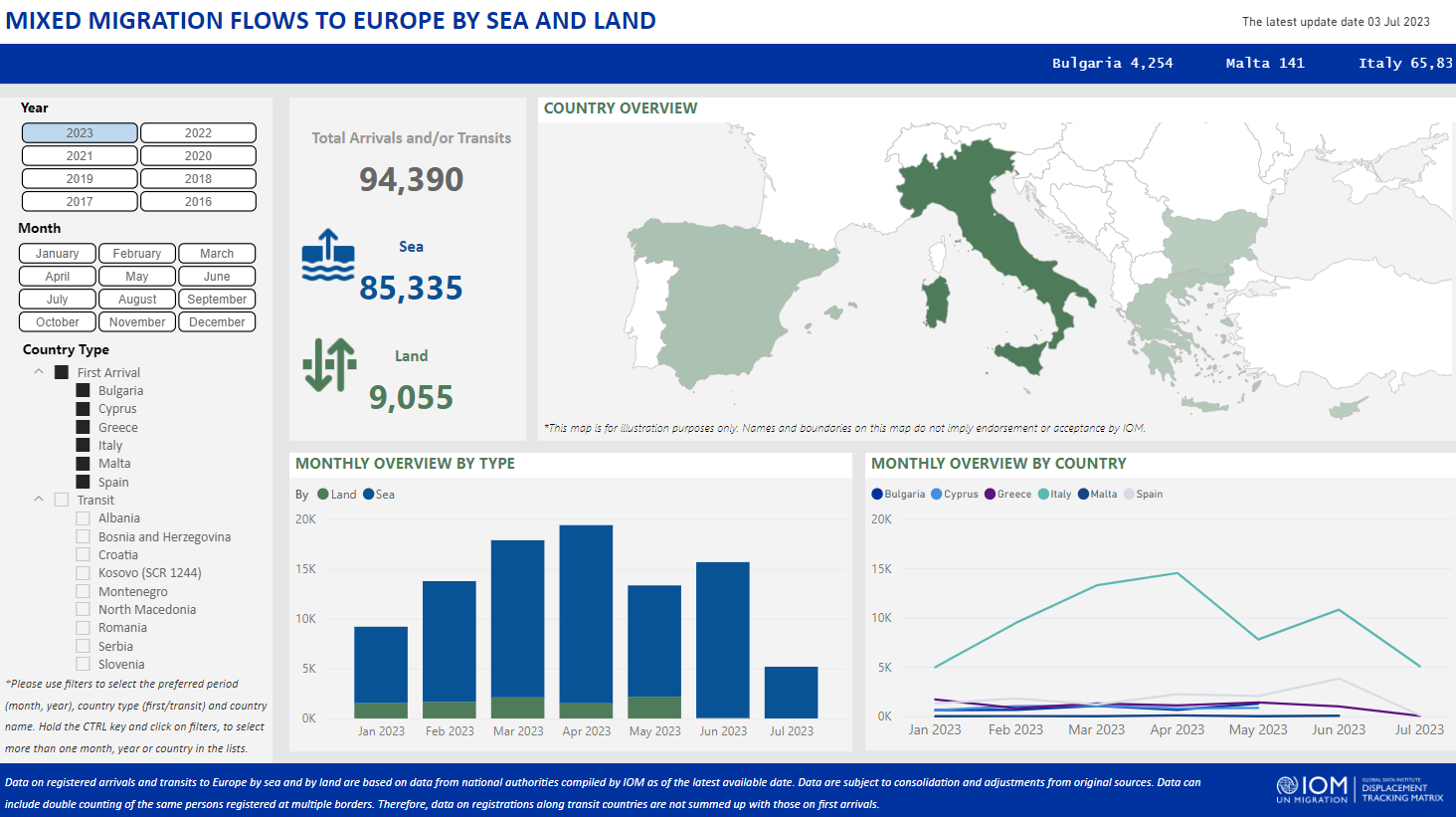-
Countries
-
Data and Analysis
-
Special Focus
-
Crisis Responses
Europe Arrivals
Total Arrivals
Arrivals by Sea
Arrivals by Land
Dead and missing migrants to Europe
Base map from Google and country shapes from ESRI are for illustration purposes only. Names and boundaries do not imply official endorsement or acceptance by IOM.
Trends over time: arrivals, death and missing migrants to Europe
| Year | Arrivals | Dead and Missing |
|---|
Monthly arrival by land and sea
Montenegro — Flow Monitoring Surveys with Migrants Travelling through Montenegro (June-August 2023)
This report presents the results of the second round of the Displacement Tracking Matrix (DTM) Flow Monitoring Surveys (FMS) implemented in Montenegro. The data was collected from 8 June to 28 August 2023. IOM interviewed a total of 126 respondents.
Türkiye — Migrant Presence Monitoring — Situation Report (March 2024)
According to the latest available gures from the Turkish Presidency of Migration Management (PMM), there are more than 4.5 million foreign nationals present in Türkiye, 3.4 million of whom are seeking international protection.
Europe — Mixed Migration Flows to Europe, Yearly Overview (2023)
DTM Europe gathers, validates and disseminates information on migrants and refugees travelling through the Mediterranean, Western African Atlantic, and Western Balkan routes to Europe.
Western Balkans — Migrant Mobility Situation Report (February 2024)
This report provides insights into the profiles, experiences, needs, routes travelled and intentions of migrants transiting through the Western Balkans.
Kosovo — Flow Monitoring Surveys with Migrants Travelling through Kosovo* (July-August 2023)
This report presents the results of the second round of the Displacement Tracking Matrix (DTM) Flow Monitoring Surveys (FMS) collected in Kosovo* from 3 July to 30 August 2023. IOM interviewed a total of 51 individual respondents. The first round of FMS was carried out in June and July 2022.
Serbia — Situacioni Izveštaj o Mobilnosti Migranata (Februar 2024)
This report, based on a multi-method and multi-source approach, provides insights into the profiles, experiences and journeys of migrants transiting through the Republic of Serbia.
Bosnia & Herzegovina — SITUACIONI IZVJEŠTAJ O MOBILNOSTI MIGRANATA (Februar 2024)
This report, based on a multi-method and multi-source approach, provides insights into the profiles, experiences, needs, routes travelled and intentions of migrants transiting through Bosnia and Herzegovina.
Mar 19 2024
Bosnia & Herzegovina — SITUACIONI IZVJEŠTAJ O…
Serbia — Migrant Mobility Situation Report (February 2024)
This report, based on a multi-method and multi-source approach, provides insights into the profiles, experiences and journeys of migrants transiting through the Republic of Serbia.
Bosnia & Herzegovina — Migrant Mobility Situation Report (February 2024)
This report, based on a multi-method and multi-source approach, provides insights into the profiles, experiences, needs, routes travelled and intentions of migrants transiting through Bosnia and Herzegovina.
Mar 19 2024
Bosnia & Herzegovina — Migrant Mobility Situat…
Western Balkans — Mixed Migratory Flows Report (February 2024)
Monthly Overview of:
Western Balkans — Mješoviti Migracijski Tokovi (Februar 2024)
Mjesečni pregled:
Western Balkans — Flukset e Përziera Migratore (Shkurt 2024)
Përmbledhje mujore të:
Western Balkans — Мешани Миграциски Текови (ФЕВРУАРИ 2024)
Месечен преглед на:
Serbia — Flow Monitoring Surveys with Migrants Travelling through Serbia (June-August 2023)
This report presents the results of the third round of the Displacement Tracking Matrix (DTM) Flow Monitoring Surveys (FMS) implemented in Serbia. FMS provides a snapshot of the profiles, experiences and needs of migrants residing in reception centres in Serbia.
Türkiye — Migrant Presence Monitoring — Situation Report (February 2024)
According to the latest available figures from the Turkish Presidency of Migration Management (PMM), there are more than 4.5 million foreign nationals present in Türkiye, 3.4 million of whom are seeking international protection.
Libya — Profile of Sudanese Migrants in Libya (March 2024)
This profile provides information on the situation and vulnerabilities of Sudanese migrants in Libya, including those having arrived after the onset of conflict in mid-April 2023 and provides an update to a brief published in
Serbia — IZVJEŠTAJ O MIGRANTSKOJ SITUACIJI (January 2024)
Ovaj izveštaj daje uvid u profil, iskustvo i putovanje migranata koji prolaze kroz Republiku Srbiju. Podaci su prikupljeni u periodu od 1. do 31. januara 2024. g. u saradnji sa Komesarijatom za izbeglice i migracije Republike Srbije (KIRS).
Bosnia & Herzegovina — Migrant Mobility Situation Report (January 2024)
This report provides insights into the profiles, experiences, needs, routes travelled and intentions of migrants transiting through Bosnia and Herzegovina (BiH).1 Data was collected from 3 January to 31 January 2024.
Feb 22 2024
Bosnia & Herzegovina — Migrant Mobility Situat…
Libya — Migrant Report 50 (October - December 2023)
IOM Libya’s Displacement Tracking Matrix (DTM) programme identified a total of 706,509 migrants from 45 nationalities in the 100 Libyan municipalities during round 50 of data collection (October - December 2023). The number of migrants in Libya increased slightly compared to the previous round of
Serbia — Migrant Mobility Situation Report (January 2024)
This report provides insights into the profiles, experiences and journeys of migrants transiting through the Republic of Serbia. Data was collected from 1 to 31 January 2024 together with the Commissariat for Refugees and Migrants of the Republic of Serbia (SCRM).
Bosnia & Herzegovina — SITUACIONI IZVJEŠTAJ O MOBILNOSTI MIGRANATA (January 2024)
Ovaj izvještaj daje uvid u profile, iskustva, potrebe i rute koje koriste, kao i namjere migranata koji se kreću kroz Bosnu i Hercegovinu (BiH)1. Podaci su prikupljani od 3. januara do 31. januara 2024. g.
Feb 22 2024
Bosnia & Herzegovina — SITUACIONI IZVJEŠTAJ O…
Migrant Report Key Findings 50 (October - December 2023)
This infographic presents the key findings of Round 50 of the mobility tracking and flow monitoring components of the Displacement Tracking Matrix (DTM) programme in Libya.
Western Balkans — Migrant Mobility Situation Report (January 2024)
This report provides insights into the profiles, experiences, needs, routes travelled and intentions of migrants transiting through the Western Balkans.
Türkiye — Migrant Presence Monitoring — Situation Report (January 2024)
According to the latest available gures from the Turkish Presidency of Migration Management (PMM), there are more than 4.6 million foreign nationals present in Türkiye, 3.4 million of whom are seeking international protection.
Pagination
Europe — Mixed Migration Flows to Europe, Yearly Overview (2023)
Mar 19 2024
<p>The file contains the following sheets</p><figure class="table"><table><tbody><tr><td><strong>Sheet</strong></td><td><strong>Content</strong></td><td><strong>Countries and Areas</strong…
Europe — Mixed Migration Flows to Europe, Quarterly Overview Dataset (July - September 2023)
Dec 05 2023
Flow Monitoring is a component of DTM and it is used to track population movements inside a country, within a region or across regions.
Europe — Mixed Migration Flows to Europe, Quarterly Overview Dataset (April - June 2023)
Sep 05 2023
Flow Monitoring is a component of DTM and it is used to track population movements inside a country, within a region or across regions.
Europe — Mixed Migration Flows to Europe, Quarterly Overview (Jan - Mar 2023)
May 22 2023
Flow Monitoring is a component of DTM and it is used to track population movements inside a country, within a region or across regions. The dataset includes: - monthly and daily figures on arrivals by sea and by land to Europe (Bulgaria, Cyprus, Greece, Italy, Malta, Spain) - monthly and…
Europe — Mixed Migration Flows to Europe, Quarterly Overview (Oct - Dec 2022)
Feb 28 2023
Flow Monitoring is a component of DTM and it is used to track population movements inside a country, within a region or across regions. The dataset includes: - monthly and daily figures on arrivals by sea and by land to Europe (Bulgaria, Cyprus, Greece, Italy, Malta, Spain) - monthly and daily…
Europe — Mixed Migration Flows to Europe, Quarterly Overview (July- September 2022)
Dec 01 2022
Flow Monitoring is a component of DTM and it is used to track population movements inside a country, within a region or across regions. The dataset includes: - monthly and daily figures on arrivals by sea and by land to Europe (Bulgaria, Cyprus, Greece, Italy, Malta, Spain) - monthly and…
Europe — Mixed Migration Flows to Europe, Quarterly Overview (Apr - Jun 2022)
Aug 16 2022
Flow Monitoring is a component of DTM and it is used to track population movements inside a country, within a region or across regions. The dataset includes: - monthly and daily figures on arrivals by sea and by land to Europe (Bulgaria, Cyprus, Greece, Italy, Malta, Spain) - monthly and daily…
Europe — Mixed Migration Flows to Europe, Quarterly Overview (Jan - Mar 2022)
May 24 2022
Flow Monitoring is a component of DTM and it is used to track population movements inside a country, within a region or across regions. The dataset includes: - monthly and daily figures on arrivals by sea and by land to Europe (Bulgaria, Cyprus, Greece, Italy, Malta, Spain) - monthly and daily…
Europe — Mixed Migration Flows to Europe, Quarterly Overview (October - December 2021)
Feb 16 2022
Flow Monitoring is a component of DTM and it is used to track population movements inside a country, within a region or across regions. The dataset includes: - monthly and daily figures on arrivals by sea and by land to Europe (Bulgaria, Cyprus, Greece, Italy, Malta, Spain) - monthly and…
Europe — Mixed Migration Flows to Europe, Quarterly Overview (July - September 2021)
Nov 12 2021
Flow Monitoring is a component of DTM and it is used to track population movements inside a country, within a region or across regions. The dataset includes: - monthly and daily figures on arrivals by sea and by land to Europe (Bulgaria, Cyprus, Greece, Italy, Malta, Spain) - monthly and daily…
Europe — Mixed Migration Flows to Europe, Quarterly Overview (April - June 2021)
Aug 27 2021
Flow Monitoring is a component of DTM and it is used to track population movements inside a country, within a region or across regions. The dataset includes quarterly data and yearly consolidated series for arrivals, transits, nationalities and migrant presence in reception for the covered…
Europe — Mixed Migration Flows to Europe, Quarterly Overview (January - March 2021)
May 04 2021
Flow Monitoring is a component of DTM and it is used to track population movements inside a country, within a region or across regions.
